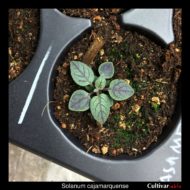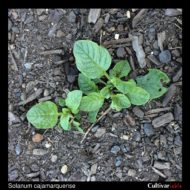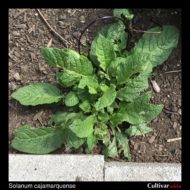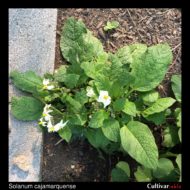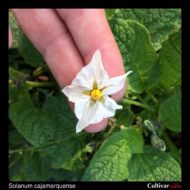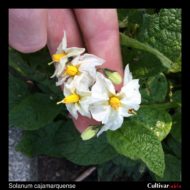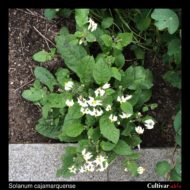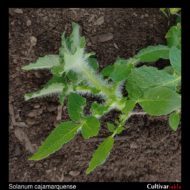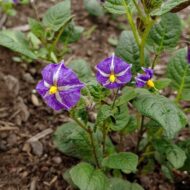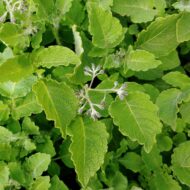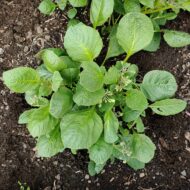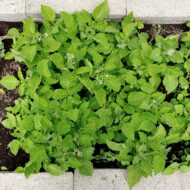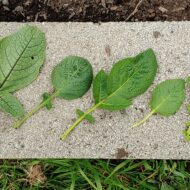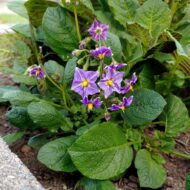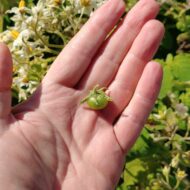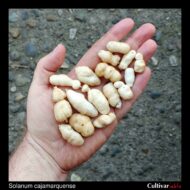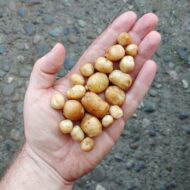No products in the cart.
Solanum cajamarquense
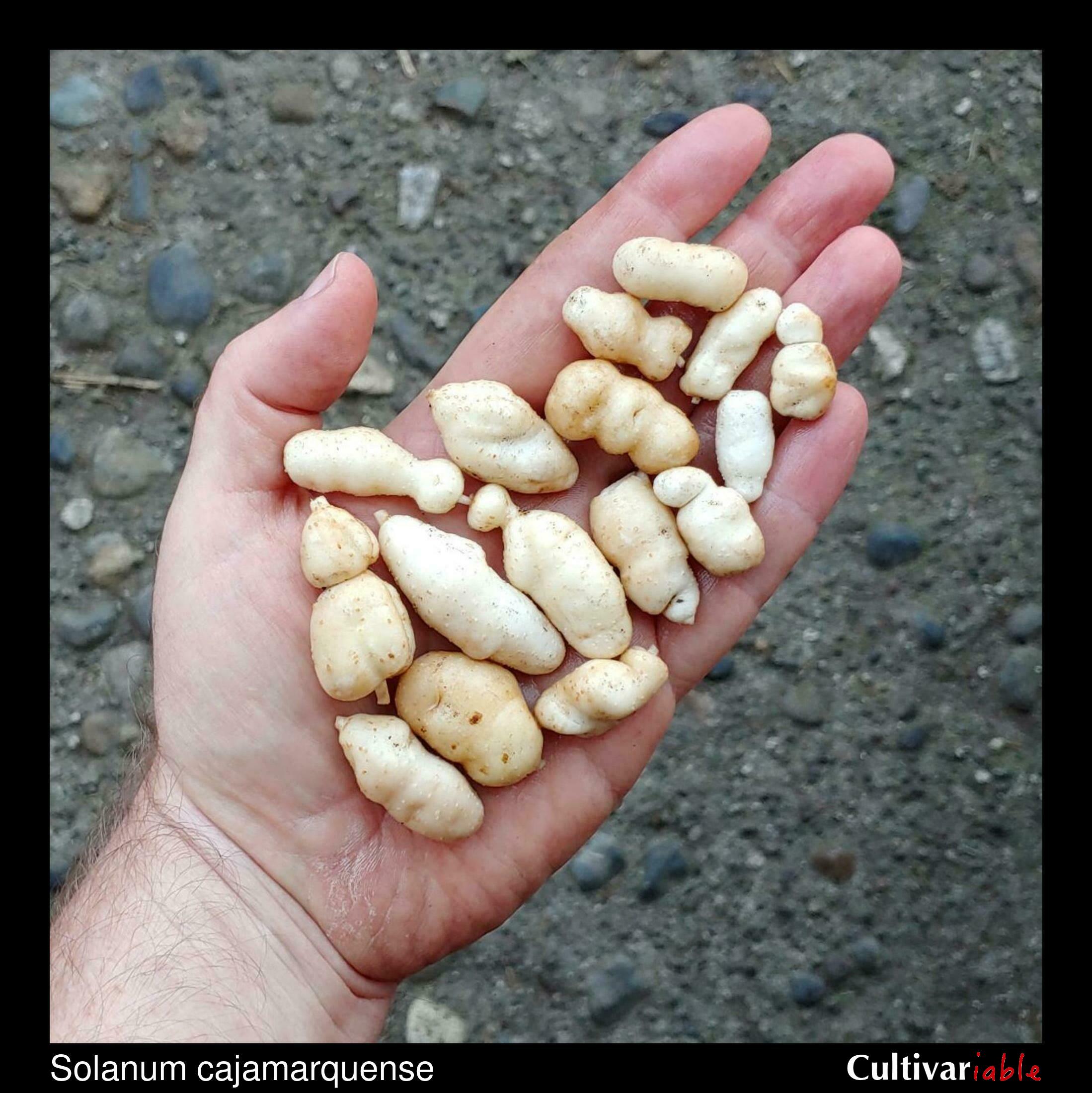
| Common Names | |
| Code | cjm |
| Synonyms | S. cajamarcense |
| Clade | 3 |
| Series | Tuberosa |
| Ploidy | Diploid (2x) |
| EBN | 1 |
| Tuberization Photoperiod | Short Day |
| Self-compatibility | No |
| Nuclear Genome | P |
| Cytoplasmic Genome | Unknown |
| Citation | Ochoa: Agronomía (Lima) 26(4): 314. 1959. |
Description
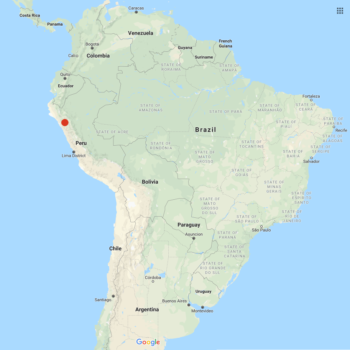
Solanum cajamarquense is an unusual species, with a small distribution in northern Peru. It grows at mid-elevations of the Andes from about 6500 to 8500 feet. Plants roughly 16 to 20 inches tall. Foliage and stems are extremely pubescent. Stolons long, exceeding two feet. Tubers small and moniliform, like beads on a string. Flowers white. Berries small, less than 1/2 inch, round to slightly compressed, green, some speckled or striped (or both).
The specific epithet, cajamarquense, refers to Cajamarca Department, Peru. While there is no completely standardized pronunciation for scientific names, the most common way to pronounce this species is probably so-LAY-num kah-ha-mar-KEN-say. If disregarding the original pronunciation of names or native words, you might instead use the pronunciation kah-ha-mar-KWEN-say.
Li (2018) placed this species in Clade 3, a group of Andean diploids, but closely neighboring Clade 1+2, North American 1EBN diploid species.
Resistances
S. cajamarquense appears to have unique late blight resistance genes (Lindqvist-Kreuze 2010). Vega (1995) found that this species is about as frost tolerant as domesticated potato. In my experience, plants took damage in a light frost that did not damage most domesticated potatoes.
Some plants of this species produce very heavy trichomes, which presumably acts as an insect deterrent.
| Condition | Type | Level of Resistance | Source |
|---|---|---|---|
| Phytophthora infestans (Late Blight) | Fungus | Resistant | Gonzales 2002, Perez 2007 |
Glykoalkaloid content
I have found no reports for this species, but most of the tubers are non-bitter.
Images
Cultivation
I have found germination of this species to be very slow, taking between one and three months. I haven’t had much luck getting tubers bigger than pinheads from this species, even when the plants are left to grow into November or December.
While the plants flower abundantly, berries are rare, which is puzzling. Most wild potatoes berry very well here and this one does not have substantially different requirements.
The pesticide carbofuran has been observed to reduce flowering in this species (Centeno-diaz 2007).
Accessions Evaluated
The following accessions were examined to prepare this profile. I have evaluated 2/2 accessions currently available from the US Potato Genebank.
PI 230522
Poor germination and relatively slow seedling growth. Dark colored seedlings. Leaves with purple undersides. Some with purple veins as well. Some with lots of very pretty blue flowers. The GRIN page for this accession lists it as S. cajamarquense, but also indicates that it is hybrid seed with PI 275149, which is an accession of S. boliviense. I inquired with the genebank and they confirmed that it is a hybrid and also provided data showing that most attempts at seed increases have failed. They also confirmed that this accession has counted out as diploid in root tip counts. This cross would presumably produce triploid (2/3 CJM and 1/3 BOL) progeny and the plants did not produce berries here when pollinated by true S. cajamarquense, which is consistent with that. A diploid result from this cross does not make sense to me, due to the differences in EBN. My best guess is that the original hybrids were triploid and 2EBN. Perhaps those were bulked together for seed, giving aneuploids between diploid and triploid and stabilizing toward diploid. This often seems to be the case with interspecies odd-ploidy hybrids.
I also noticed that Binquan (2019) reported that this accession grouped in such a way that it suggested introgression from clade 4, which is consistent with its hybrid nature.
This accession demonstrated much better frost resistance than pure S. cajamarquense. The tubers are somewhat sour. Berries rounder than those of pure CJM, green with the occasional speckle.
PI 310988
Good germination and relatively strong seedling growth. Light colored, pubescent seedlings. Leaves with green undersides. Very vulnerable to frost.
Breeding
Crosses with S. tuberosum
| Female | Male | Berry Set |
Seed Set | Germ | Ploidy | Source |
|---|---|---|---|---|---|---|
Crosses with other species
| Female | Male | Berry Set |
Seed Set | Germ | Ploidy | Source |
|---|---|---|---|---|---|---|
References
Solanum cajamarquense at Solanaceae Source

